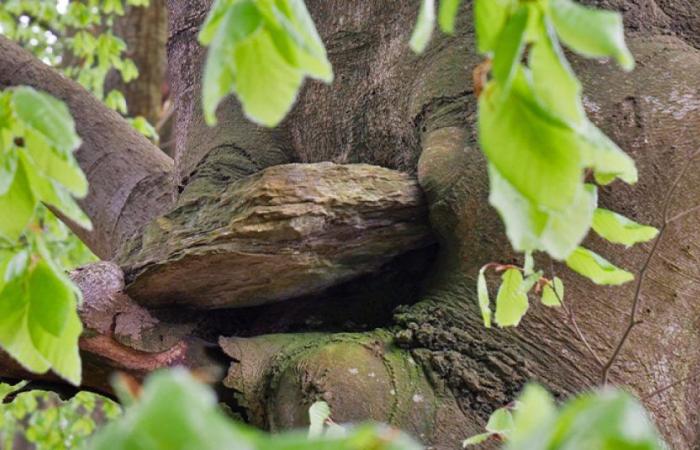The sky suddenly darkened. Deep thunder comes from the north, the vibrations of which travel up the hills, making them tremble. We have to move, a strong storm will soon hit this area of the Langhe that few know about, beyond Piedmont, in Ligurian territory: long humps stretching towards the sea.
Before getting back on the off-road vehicle I turn to observe the large beech tree for the last time. Seen like this, against the light, it makes an even more impressive impression: its branches, twisted by the breezes from the ridge, almost completely hide that strange and unusual presence that we have come here to look for: a rock.
Shaken by a gust of wind, I feel two figures entering my thoughts, who I imagine walking right in front of me, among the smooth barks of trees. foas beech trees are called in these parts.
They are a man and a little girl, walking among the plants on the ridge.
He holds a fairly heavy basket with one hand, in the other he has a stick with which he slowly lifts the damp leaves. She only has a small backpack on her shoulders, in bright colors, signed by some fashionable brand.
The man proceeds slowly, with his head bowed towards the ground. He taught her to do the same. “To find mushrooms you have to be concentrated, attentive, scan the ground meter by meter”, he had repeated to her for the umpteenth time before leaving. But she just can’t follow that precious advice of hers. To the brown of rotten leaves and mushroom caps she much prefers the clouds and the blue of the sky, which mix with the strange shapes of the branches. So she proceeds with her nose turned up and her feet stumbling among the protruding roots.
At a certain point she stops, remains motionless and thoughtful beneath an enormous, twisted, humped trunk. Among the branches, four or perhaps five meters above the ground, he sees something unusual: a large gray stone, which seems to have been forced into the trunk of the tree.. She calls the man and shows her that mysterious object: “How did such a large stone end up up there?”
He remains astonished, thoughtful, unable to utter a word. Rather than reflect on a possible and realistic solution to that complicated question, he hastily tries to invent a story, an excuse. He doesn’t want to show her at all that he doesn’t have the faintest idea of how a stone of such dimensions could have ended up up there, among the branches of an old beech tree. But while he awkwardly tries to stammer something he hears her running towards another curious object that he has just seen appear in the woods, not far away. It is a greyish statue, in the shape of Italy, stained with dark stripes from the dripping of decades. There is a small photo of a now unrecognizable face and a writing that follows the shapes of the peninsula.
In the second fortnight of June 1944, a group of young people from the resurrected Italy, rebels against the Nazi-Fascist yoke, here gave rise to the glorious Savona Brigade named after the fallen Furio Sguerso.
The man reaches the little girl, observe that old monument now almost surrounded by vegetation and suddenly remember. A village voice, passed down between the pews of the church and the tavern counter, which he heard from his father, or grandmother, perhaps it was his uncle. It does not matter: now it has resurfaced, freed from the labyrinths of time.
Thus they return to the large beech tree. He tells her it’s a good place to sit and have something to eat. He then points to the stone above their heads and whispers seriously: “That Saxon is called memory”. She doesn’t understand, but she doesn’t stop looking at the strange growth.
“The beech, in eighty years, has almost eaten the stone, season after season, ring after ring. Just like time, which is slowly eating away at memory”, he says.
“Memory of what?”, the little girl then asks.
“You’ve already studied those young people the monument talks about, the Partisans, right?”, replies the man. “Once we get here, al Ciànlàzafter having camped on the Montebri and then to The Termu, they had decided to install a new camp. It was a remote place, quite safe, from which they could observe the valleys all around: towards The Ravagnito the north, and the Ferranietta ValleySouth. To create the lookout posts they had inserted large flat stones between the branches of the beech trees. They sat comfortably up there, taking turns, to scan every movement in the surrounding area. After the war, over the years, the stones fell from the branches, but one didn’t, it got stuck. And as the tree grew, it held her close to itself, starting to incorporate it into its tissues, to eat it. Someone had told me about this stone many years ago, but I never went up to look for it. And then I completely forgot about it, I lost a piece of my memory. Today, as usual, you didn’t find even one büle… but something much more precious, which you can keep forever, if you want.”
“The memory?”
“Memory, yes. A piece of memory, which has the shape of a stone incorporated into a tree.”

The storm has arrived and is now dumping white balls on the windshield of the off-road vehicle: a small snowstorm at the end of April, among the trees with their leaves almost completely shed. Emiliano Botta, Forestry Doctor and animator of the management of local forests together with the other partners of the IN VOUDERM project, spoke to me about the beech and the stone at the end of a long day of work. The story came out by chance, together with a flood of words: toponyms, anecdotes, ideas, projects. It’s done like this: a bit like reading Jack Kerouac’s books, a chat with him is an uninterrupted stream of consciousness closely linked to his territory, which he knows meter by meter.
“You absolutely have to take me there!” I told him decisively, stopping that flow of thoughts as soon as I heard mention of the beech tree with the stone of the partisan lookout post stuck in it.
“I know where the place is, but I just couldn’t pinpoint the exact plant,” he replied. So he picked up the phone and called a fellow villager from Rocchetta. The indications, in dialect, were a meticulous sequence of toponyms, which fortunately still survive here, giving a name and meaning to every single corner of the countryside and woods. Finding the large beech tree was therefore relatively simple, if nothing, a Ciànlàzindicates its presence: not an arrow, not a sign.
Finding and observing that old lookout stone up there, incorporated by the trunk, was an experience difficult to explain. However, I can say one thing: it moved me more than many high-sounding monuments. That tree preserves a piece of memory, but at the same time eats it and hides it, year after year. That large beech tree therefore becomes a metaphor for all of us: for me, for Emiliano, for the imaginary man and little girl, for Commander Bacchetta and Commander Tom, who organized the Savona Brigade up here, or for Mr. Cesarino, who explained to us how find the plant.
Holding on to your memory and at the same time losing it in the meanders of time are basically two sides of the same coin, which we all experience every day. But that large stone is there, it is an indelible presence outside and inside us: the Resistance has changed our lives just as that stone made the grain in the wood of the tree sway and contort. In those folded, but not broken, fibers, one can read the intricate path towards the conquest of freedom.
I think that beech tree found by chance is a real living monument. That plant and that stone should be shown and told to boys and girls. I think that this place, like many others in the mountains of Italy, should once again become a pilgrimage destination, one of those suggested by Piero Calamandrei.
This is how it just happened for me, on the eve of a new April 25th.
“If you want to go on a pilgrimage to the place where our Constitution was born, go to the mountains where the partisans fell, to the prisons where they were imprisoned, to the fields where they were hanged. Wherever an Italian has died to redeem freedom and dignity, go there young people, with your thoughts, because our Constitution was born there”








